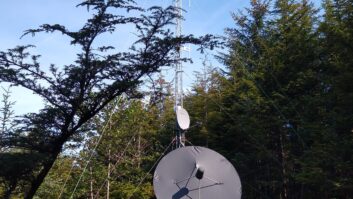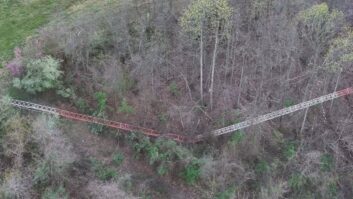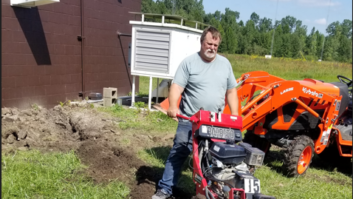Sun, Wind and Fuel Cells
Sep 1, 2009 12:00 PM, By Doug Irwin, CPBE DRB AMD
Jumping on the bandwagon while sales are slow may produce unforeseen advantages in the future.
Even with energy prices temporarily on the wane there is still a substantial desire amongst many companies to go green and reduce their non-renewable energy usage to the extent practicable within good business practices. In other words, an investment in alternative energy sources still has to be a good investment. With sales slow in so many industries (not just the radio industry) now is a good time to be a buyer; and since energy prices are bound to rise with the end of the recession, the best time to invest in alternate energy may be now. Waiting til energy prices rise will surely give an advantage back to the sellers, thus diminishing the potential ROI.
This is not an article about getting off of the grid though � it’s really more about energy conservation. The systems I will mention typically supply on the order of 1kW of power. Unfortunately it just isn’t financially viable at this point in time to generate enough power to supply the needs of a 50kW AM transmitter facility (for example). The kinds of systems in this article are grid-connected, and supplant the energy drawn from the ac power grid, at least over part of the day. Solar photovoltaic arrays, wind generators and finally fuel-cells are the types we’ll cover.
Storing energy
Solar power and wind power complement one another because usually when the sun is most intense, the wind is weakest; and likewise, it is often windiest when the sun isn’t shining. Since broadcasting is a 24-hour-per-day business, our energy needs are mainly constant over the course of the day; but even with wind and solar energy working together, their combined energy output can vary dramatically over 24 hours. For this reason it is often necessary to store excessive energy during the best times of the day, so that the excess can be used by the load during times of the day that the wind or solar power sources are at their weakest. The output of solar arrays is always dc, and used to charge batteries directly. Large inverters are then used to generate ac power for loads that require it. Wind generators come in one of two styles: those that charge batteries, like their solar cell counterparts, or those that have inverters that take dc power from an alternator turned by the blades while the wind is blowing, and then subsequently turn that into ac via an inverter. Usually that type of inverter is connected directly to the line power via a circuit breaker in your ac distribution panel. The inverter synchronizes its frequency and phase, and sets its output voltage accordingly.

Solar arrays can be mounted in many ways and can follow the sun to maximize power with solar trackers.
Even when using wind and solar together, you would likely find times when there was simply not enough energy generated over the course of the day (even with batteries storing energy during the best times of the day) to remove yourself totally from the power grid; for that reason, you may want to consider a means by which you can use non-renewable (or should we call them �remnant�) energy sources, such as natural gas or propane, as a third, or backup source of power. That’s where fuel-cells come in. We’ll get to those a little later.
When using alternative power sources you will want to be as efficient as possible in your energy usage. We’ve all become a little spoiled with the ac power grid. For the most part you can just keep plugging things in � and the source can handle it. When you start making your own power, you effectively lose that crutch. Your alternative power source will have a limit to what it can do in terms of supply, so you’ll need to count your watts carefully.
Sun, Wind and Fuel Cells
Sep 1, 2009 12:00 PM, By Doug Irwin, CPBE DRB AMD
Jumping on the bandwagon while sales are slow may produce unforeseen advantages in the future.
Solar arrays
Flat solar arrays can be mounted in various fashions: on the roof of your building, on the roof of a parking structure, or in arrays mounted on the ground. In any of those cases the angle with respect to the ground is set to optimize the array’s exposure to the sun. Typically the output voltage of a single solar panel (which in turn is made up of an array of individual cells) is on the order of 24V; these units obviously can be connected in parallel to provide a higher current capacity. A Kyocera KD205, for example, will put out about 150W with 800W per square meter of irradiance; this is 6A at 24Vdc out. The size of this array is 59″ by 39″ by about 1.5″. The cost of this particular array is on the order of $1000.
I’m quite sure many enterprising broadcast engineers could develop their own systems out of building blocks such as this particular solar array.
The output of the solar array will obviously be greatest when the rays of sun are perpendicular to the array itself; simple trigonometry shows the output of the array is going to be proportional to the sine of the angle of incidence between the rays of sunlight and the array. Therefore it would seem that to maximize the output of the array, some sort of steering, to keep the arrays at the optimum angle with respect to the sun, is called for. The Premiere Power Solar Tracker is one such system that accomplishes this. Another system which does this, in a totally passive manner, is the Zomeworks Universal Track Rack. This device uses gravity and the heating power of sunlight itself to align the flat arrays for maximum output.

Wind turbines take more consideration than solar panels, like height, trees, noise and other nearby structures.
If you are thinking big, though, and want to generate a more substantial amount of power via photovoltaics, you might want to consider Solfocus of Mountain View, California. They make use of technology known as CPV, or concentrated photovoltaics. This system generates more power with the same amount of irradiance; additionally the system tracks the sun. You can learn more about a project that Solfocus did with KGO radio from the article Feel the Power in the July 2008 edition of Radio magazine.
Wind turbines
Recovering energy from the wind is not quite as simple as getting it from the sun. Though the sun shines everywhere every day (to some extent anyway) the amount of wind that an area gets on a day-to-day basis isn’t that obvious. If you want to consider using wind power, then the first thing to do is to take a look at this website: www.windpoweringamerica.gov/wind_maps.asp. From this site you can get a very good idea about what the potential for wind power is at your particular site.
Assuming you’ve determined your site has good potential, there are other factors that need to be considered before you purchase a wind turbine. Wind turbines are mounted on towers, typically 40″ to 50″ high. They do make a certain amount of noise, and are negatively affected by the presence of trees and other structures nearby that make the air more turbulent. Therefore you should plan on having open land around the base of the tower (about one acre for a 40″ to 50″ tower is what I have been told). Obviously you should investigate any zoning restrictions that may be in place at the area in which you desire to build the tower.
Sun, Wind and Fuel Cells
Sep 1, 2009 12:00 PM, By Doug Irwin, CPBE DRB AMD
Jumping on the bandwagon while sales are slow may produce unforeseen advantages in the future.
Now assuming your site is perfectly suited for the construction of a tower that will be topped with a wind turbine, you need to consider the model. If you want to power a small facility then at the very least you should consider the Skystream 3.7 from Southwest Wind Power. This is a wind generator that has a peak output rating of 2.4kW at a wind speed of 13m/s. It comes in two different versions: one set up for charging batteries, and one that has a built-in inverter that allows the unit to be connected directly the power grid via your ac power panel (240Vac single phase).
There again, if you are thinking bigger is better, consider the Excel from Bergey Wind Corporation. This wind turbine also comes in battery charging versions as well as the version for grid-connect (240Vac single phase output requires the addition of an optional inverter). Maximum output in a 13m/s wind is 10kW. Bergey also supplies towers for the Excel, the minimum height of which is 60″.

The Clear Edge CE5 fuel cell makes use of natural gas or propane as the fuel source.
There are great tax incentives in place now that will offset a substantial fraction of the cost of solar and wind systems. Both federal and state incentives exist, so discuss their impact with your vendor. The total incentive will vary on a state-by-state basis.
Fuel cells
Fuel cells are about to become an option for power generation. Matsushita has developed a PEFC fuel cell, using natural gas as the fuel, that will provide up to 1kW of output (single phase 60Hz). They are promising this unit will be available in the first quarter of 2010. One byproduct of the chemical process by which the fuel cell works is the creation of hot water � ideal for the home of course.
Natural gas probably would not be an option for a transmitter site, but propane certainly is. The Clear Edge CE5 is a fuel cell that can make use of natural gas or propane as the fuel source. This unit measures 34″ by 26″ by 65″ in height, can be installed inside or out, and can provide up to 40A of current at 240Vac. It also makes hot water as a byproduct. It’s a little quieter than a generator, too: 60dBA at 3″.
Could a device such as this be the third of a triad that will allow you to get off the grid?
By recovering energy that is freely available � either from the wind or from the sunlight that shines down on us every day � you can play an active role in the greening of the world. You’ll also buy yourself a certain amount of energy independence. As far as investments go, alternative power is not that great � you can make more money with certificates of deposit. We don’t know what the future holds for energy prices � but it seems more likely they will increase, rather than decrease. An investment in alternative power may pay off down the road in ways that are hard to imagine today.
Irwin is transmission systems supervisor for Clear Channel NYC and chief engineer of WKTU, New York. Contact him at[email protected].











